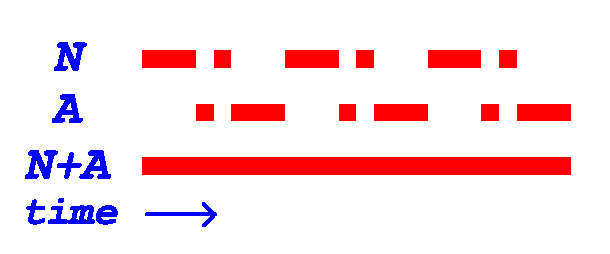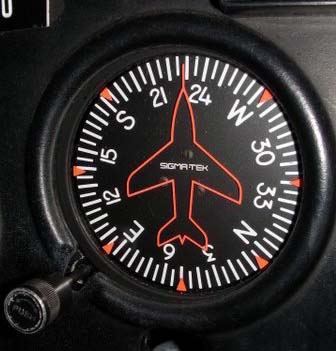|
Radio Range
The low-frequency radio range, also known as the four-course radio range, LF/MF four-course radio range, A-N radio range, Adcock radio range, or commonly "the range", was the main Radio navigation, navigation system used by aircraft for instrument flight rules, instrument flying in the 1930s and 1940s, until the advent of the VHF omnidirectional range (VOR), beginning in the late 1940s. It was used for en route navigation as well as instrument approaches and Holding (aviation), holds. Based on a network of radio towers which transmitted Radiation pattern, directional radio signals, the radio range defined specific Airway (aviation), airways in the sky. Pilots navigated using low-frequency radio by listening to a stream of automated "A" and "N" Morse codes. For example, they would turn the aircraft to the right when hearing an "N" stream ("dah-dit, dah-dit, ..."), to the left when hearing an "A" stream ("di-dah, di-dah, ..."), and fly straight ahead while hearing a steady tone. As ... [...More Info...] [...Related Items...] OR: [Wikipedia] [Google] [Baidu] |
Instrument Flight Rules
In aviation, instrument flight rules (IFR) is one of two sets of regulations governing all aspects of civil aviation aircraft operations; the other is visual flight rules (VFR). The U.S. Federal Aviation Administration's (FAA) ''Instrument Flying Handbook'' defines IFR as: "Rules and regulations established by the FAA to govern flight under conditions in which flight by outside visual reference is not safe. IFR flight depends upon flying by reference to instruments in the flight deck, and navigation is accomplished by reference to electronic signals." It is also a term used by pilots and controllers to indicate the type of flight plan an aircraft is flying, such as an IFR or VFR flight plan. Basic information Comparison to visual flight rules It is possible and fairly straightforward, in relatively clear weather conditions, to fly an aircraft solely by reference to outside visual cues, such as the horizon to maintain orientation, nearby buildings and terrain features for n ... [...More Info...] [...Related Items...] OR: [Wikipedia] [Google] [Baidu] |
Army Signal Corps
The United States Army Signal Corps (USASC) is a branch of the United States Army that creates and manages communications and information systems for the command and control of combined arms forces. It was established in 1860, the brainchild of Major Albert J. Myer, and had an important role in the American Civil War. Over its history, it had the initial responsibility for portfolios and new technologies that were eventually transferred to other U.S. government entities. Such responsibilities included military intelligence, weather forecasting, and aviation. Mission statement Support for the command and control of combined arms forces. Signal support includes network operations (information assurance, information dissemination management, and network management) and management of the electromagnetic spectrum. Signal support encompasses all aspects of designing, installing, data communications networks that employ single and multi-channel satellite, tropospheric scatter, terrestrial ... [...More Info...] [...Related Items...] OR: [Wikipedia] [Google] [Baidu] |
Federal Aviation Administration
The Federal Aviation Administration (FAA) is the largest transportation agency of the U.S. government and regulates all aspects of civil aviation in the country as well as over surrounding international waters. Its powers include air traffic management, certification of personnel and aircraft, setting standards for airports, and protection of U.S. assets during the launch or re-entry of commercial space vehicles. Powers over neighboring international waters were delegated to the FAA by authority of the International Civil Aviation Organization. Created in , the FAA replaced the former Civil Aeronautics Administration (CAA) and later became an agency within the U.S. Department of Transportation. Major functions The FAA's roles include: *Regulating U.S. commercial space transportation *Regulating air navigation facilities' geometric and flight inspection standards *Encouraging and developing civil aeronautics, including new aviation technology *Issuing, suspending, or revoking ... [...More Info...] [...Related Items...] OR: [Wikipedia] [Google] [Baidu] |
Adcock Antenna
The Adcock antenna is an antenna array consisting of four equidistant vertical elements which can be used to transmit or receive directional radio waves. The Adcock array was invented and patented by British engineer Frank Adcock in 1919 as British Patent No. 130,490, and has been used for a variety of applications, both civilian and military, ever since. (Note: The patent lawyer's name appears as inventor, with "F. Adcock" in parentheses, since Lt. Adcock, RE was serving in wartime France at the time.) Although originally conceived for receiving low frequency (LF) waves, it has also been used for transmitting, and has since been adapted for use at much higher frequencies, up to ultra high frequency (UHF). In the early 1930s, the Adcock antenna (transmitting in the LF/MF bands) became a key feature of the newly created radio navigation system for aviation. The low frequency radio range (LFR) network, which consisted of hundreds of Adcock antenna arrays, defined the airways use ... [...More Info...] [...Related Items...] OR: [Wikipedia] [Google] [Baidu] |
Loop Antenna
A loop antenna is a radio antenna consisting of a loop or coil of wire, tubing, or other electrical conductor, that is usually fed by a balanced source or feeding a balanced load. Within this physical description there are two (possibly three) distinct types: * Large loop antennas (or ''self-resonant loop antennas'') have a perimeter close to one or more whole wavelengths at the operating frequency, which makes them self-resonant at that frequency. They are the most efficient of all antenna types for both transmission and reception. Large loop antennas have a two-lobe radiation pattern at their first, full-wave resonance, peaking in both directions ''perpendicular'' to the plane of the loop. * Halo antennas are shortened dipoles that have been bent into a circular loop, with the ends not quite touching. Some writers prefer to exclude them from loop antennas, since they can be well-understood as bent dipoles, others make halos an intermediate category between large and small loo ... [...More Info...] [...Related Items...] OR: [Wikipedia] [Google] [Baidu] |
Turn And Bank Indicator
In aviation, the turn and slip indicator (T/S, a.k.a. turn and bank indicator) and the turn coordinator (TC) variant are essentially two aircraft flight instruments in one device. One indicates the rate of turn, or the rate of change in the aircraft's heading; the other part indicates whether the aircraft is in coordinated flight, showing the slip or skid of the turn. The slip indicator is actually an inclinometer that at rest displays the angle of the aircraft's transverse axis with respect to horizontal, and in motion displays this angle as modified by the acceleration of the aircraft. The most commonly used units are degrees per second (deg/s) or minutes per turn (min/tr). Name The turn and slip indicator can be referred to as the turn and bank indicator, although the instrument does not respond directly to bank angle. Neither does the turn coordinator, but it does respond to roll rate, which enables it to respond more quickly to the start of a turn. Operation Turn indicato ... [...More Info...] [...Related Items...] OR: [Wikipedia] [Google] [Baidu] |
Invention And Technology Magazine
''Invention & Technology Magazine'' (formerly known as ''American Heritage of Invention & Technology'') is a quarterly magazine dedicated to the history of technology. It was launched with sponsorship from General Motors in the summer of 1985 as a spinoff of ''American Heritage'' magazine. Later, the magazine had a partnership with the National Inventors Hall of Fame. “Our subject matter is actually nothing less than the making of the world we live in, and the stories of all the extraordinary people who made it,” wrote Frederick Allen, the Founding Editor, in 1985. He noted that the field of the history of technology is relatively new. "Up to now there has been no general magazine of wide circulation reporting on it. A gap exists between the findings of the scholars and the educated public," he wrote. There were three issues of the magazine a year until 1992, when it became quarterly. Following the Summer 2007 issue (volume 23, number 1), publication was suspended (along with ... [...More Info...] [...Related Items...] OR: [Wikipedia] [Google] [Baidu] |
Aircraft Heading
In navigation, the heading of a vessel or aircraft is the compass direction in which the craft's bow or nose is pointed. Note that the heading may not necessarily be the direction that the vehicle actually travels, which is known as its '' course'' or ''track''. Any difference between the heading and course is due to the motion of the underlying medium, the air or water, or other effects like skidding or slipping. The difference is known as the ''drift'', and can be determined by the ''wind triangle''. At least seven ways to measure the heading of a vehicle have been described. Notation Heading is typically based on cardinal directions, so 0° (or 360°) indicates a direction toward true north, 90° true east, 180° true south, and 270° true west. TVMDC TVMDC is a mnemonic for converting true, magnetic and compass headings. TVMDC is a mnemonic initialism for true heading, variation, magnetic heading, deviation, compass heading. The most common use of the TVMDC method is co ... [...More Info...] [...Related Items...] OR: [Wikipedia] [Google] [Baidu] |
Aircraft Attitude
Flight dynamics is the science of air vehicle orientation and control in three dimensions. The three critical flight dynamics parameters are the angles of rotation in three dimensions about the vehicle's center of gravity (cg), known as ''pitch'', ''roll'' and ''yaw''. These are collectively known as aircraft attitude, often principally relative to the atmospheric frame in normal flight, but also relative to terrain during takeoff or landing, or when operating at low elevation. The concept of attitude is not specific to fixed-wing aircraft, but also extends to rotary aircraft such as helicopters, and dirigibles, where the flight dynamics involved in establishing and controlling attitude are entirely different. Control systems adjust the orientation of a vehicle about its cg. A control system includes control surfaces which, when deflected, generate a moment (or couple from ailerons) about the cg which rotates the aircraft in pitch, roll, and yaw. For example, a pitching mo ... [...More Info...] [...Related Items...] OR: [Wikipedia] [Google] [Baidu] |
Heading Indicator
The heading indicator (HI), also known as a directional gyro (DG) or direction indicator (DI), is a flight instrument used in an aircraft to inform the pilot of the aircraft's heading. Use The primary means of establishing the heading in most small aircraft is the magnetic compass, which, however, suffers from several types of errors, including that created by the "dip" or downward slope of the Earth's magnetic field. Dip error causes the magnetic compass to read incorrectly whenever the aircraft is in a bank, or during acceleration or deceleration, making it difficult to use in any flight condition other than unaccelerated, perfectly straight and level. To remedy this, the pilot will typically maneuver the airplane with reference to the heading indicator, as the gyroscopic heading indicator is unaffected by dip and acceleration errors. The pilot will periodically reset the heading indicator to the heading shown on the magnetic compass.Bowditch, NathanielAmerican Practical Na ... [...More Info...] [...Related Items...] OR: [Wikipedia] [Google] [Baidu] |







